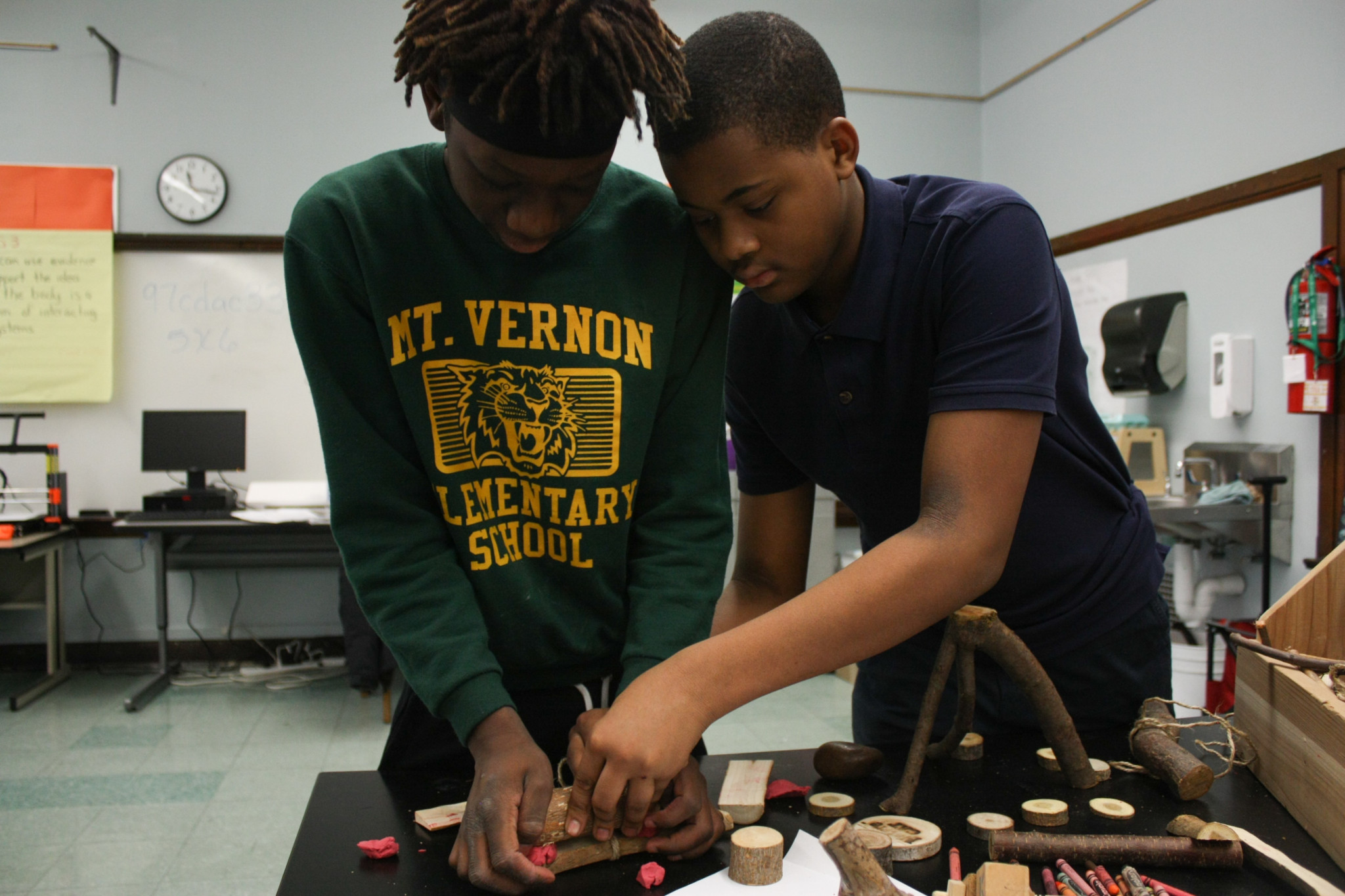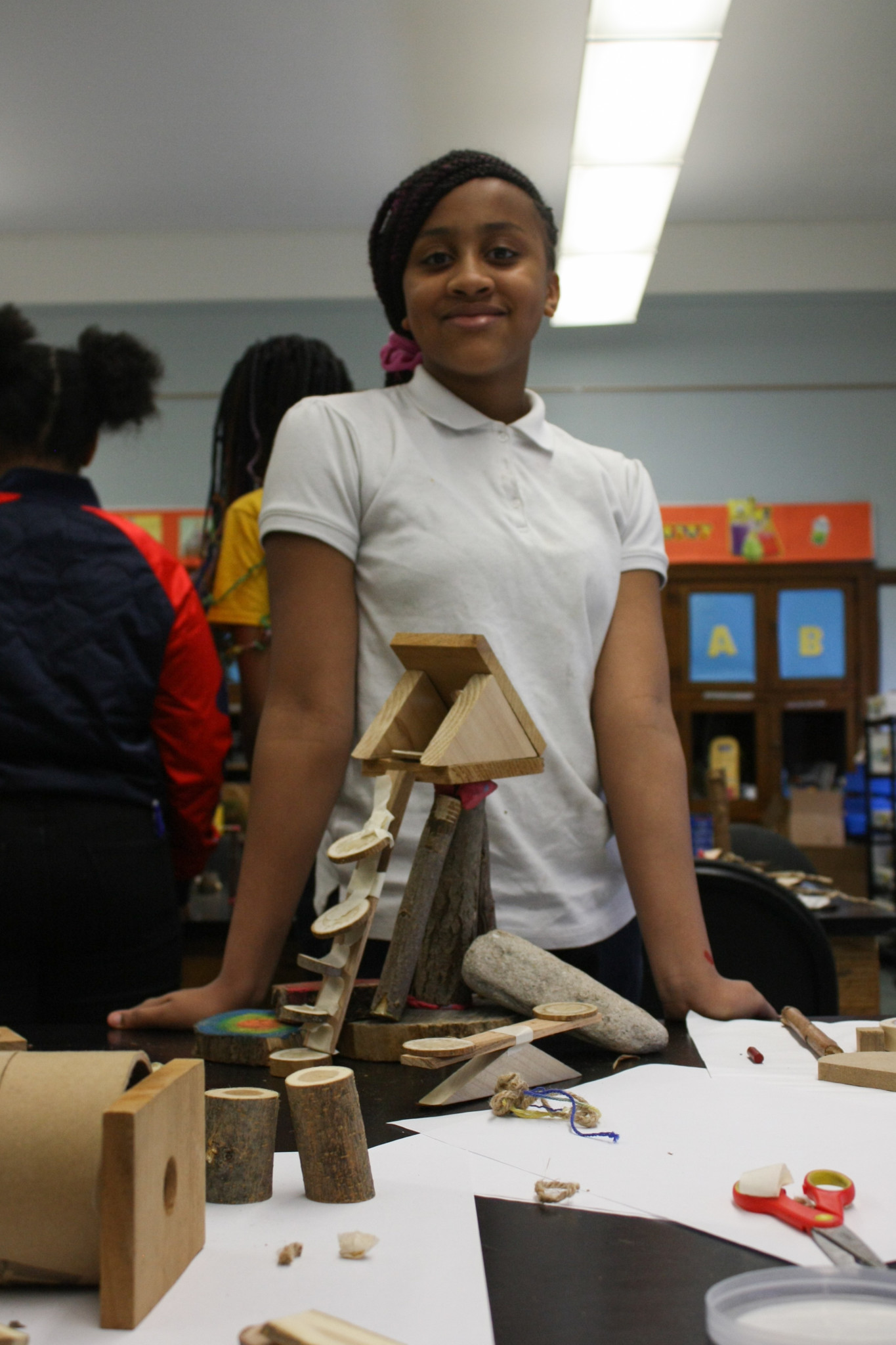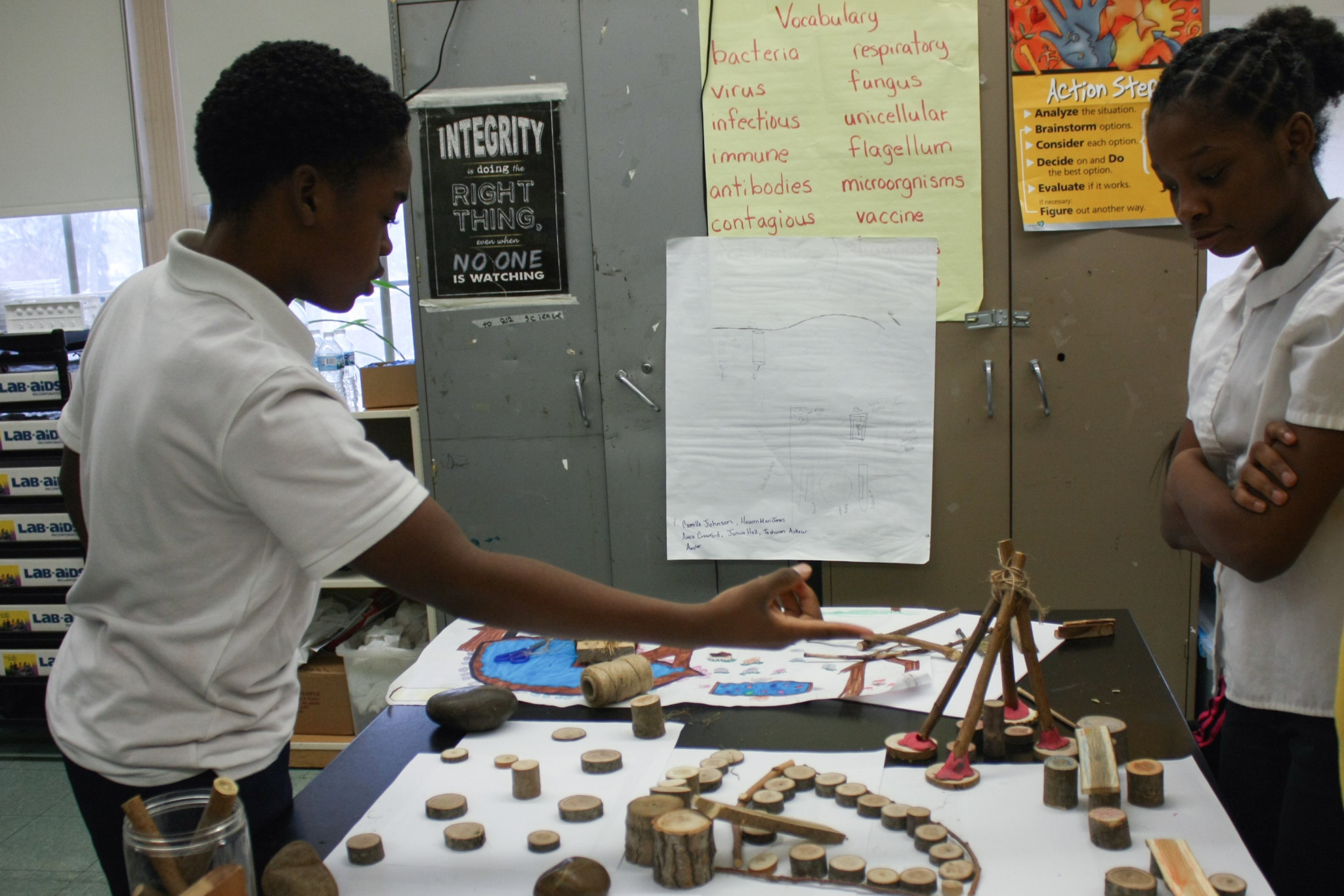The kids in Ms. Pender-Bey’s eighth grade class at Mount Vernon Elementary will soon be preparing to depart for high school. But before they go, they’re leaving their mark on the neighborhood.
The class is designing their own nature playspace to be built in Jackie Robinson Park, directly adjacent to the Washington Heights school.
On a snowy January morning, Pender-Bey’s students eagerly gathered in the science lab, where Chicago Park District employees Sean Shaffer and Isaiah Ballinger had laid out paper, crayons, and special toolboxes loaded up with necessary supplies: sticks, rocks, putty, string, and, to the excitement of one of the tables at the front of the classroom, what looked like a kind of hickory nut.
The kids hardly needed instructions; after a brief introduction, they jumped to it. Zachary and Nazir built a swing from sticks and rope and a seating circle made from branch rounds, while a couple tables down Ronaisha and Mikah worked on designing hopscotch and life-size tic-tac-toe courts and a maze made from sticks. Around the room all sorts of model structures started to rise: tree houses, sand boxes, slides, peace circles, bridges, and islands.

Helping kids design their own playspaces is a big part of the job for Shaffer. A longtime educator and park district employee, a year and a half ago he became the district’s nature education specialist—a position created for him—after realizing how important it was for kids to have access to natural spaces where they can engage in unstructured play.
Nature playspaces and play gardens have been popping up across the city over the last several years, thanks to the park district and to organizations like NeighborSpace and Openlands. Pocket parks that are often filled with hills of mulch, tree stumps, and hollowed out log tunnels—and lots of sticks—these playspaces aren’t quite blank canvases, but unlike traditional playgrounds full of fixed structures they are designed to be built and rebuilt again, and again, and again.
“If you give them planks and stumps, kids can create a seesaw and then the next day, [say] ‘We want it to be a ramp, a castle,’ or whatever they see,” Shaffer said.
Sticks and logs break down over time. That’s part of the fun, Shaffer said: “It’s all loose parts, logs and sticks, that are meant to break down and become more interesting until they’re nothing.”
Once the sticks and logs are nothing—once they’ve disintegrated or otherwise become too small to be played with—the park district needs to restock the playspace. Park district staff have addressed this potential supply problem by learning themselves to look at natural debris as play material: a fallen tree as a potential clambering structure, a large branch as a beam in a fort. Shaffer says he gets texts throughout the course of the week from crew members asking if a tree or other object could work in a playspace.
So far, Shaffer has helped oversee the design and construction of eight park district playspaces including in Hyde Park, Northerly Island, and the North Park Village Nature Center where he is based. By his count there are another eleven in some stage of the planning process, which will include Marquette Park, Douglas Park, and Rogers Park.

Shaffer and the park district are in good company with NeighborSpace and Openlands, both nonprofit organizations that have helped communities develop similar spaces throughout the city.
Openlands helps lead an initiative called “Space to Grow,” which transforms Chicago Public Schools land into green playspaces and gardens, which also helps to reduce flooding by relieving pressure on the stormwater system.
NeighborSpace, which until recently focused on buying land for and maintaining community gardens, first started working with nature play spaces in 2013 after being approached by community organizations and residents in Little Village who wanted a community playspace, Robin Cline, NeighborSpace’s assistant director, said. The garden was completed in 2015, after two years of in-depth community planning, and more followed, in McKinley Park, North Lawndale, and Humboldt Park. And more are planned, on the Far Southeast Side, in Austin, and in Garfield Park—the latter two as part of the West Side Nature Play Network.
“More and more communities are coming to us with requests and desires to figure out how to meet the needs of their communities that are not necessarily met by [playgrounds or] traditional community gardens,” Cline said. “One of the [important aspects] of community-managed nature play is the need for intergenerational space that allow for community building… and for kids to play in nature and in their own neighborhoods.”
Though one of the biggest proponents of the nature play movement is based in North Carolina, Cline said, the movement is really international, with roots in Scandinavia. “More and more we’re recognizing the importance… [of] providing opportunities for early childhood play and decision-making.” And not just for kids, but for parents too. “The community stewardship that happens in these play gardens,” she said, referring to plantings and other community work days that occur in play gardens, ”reflects adult play.”
When Shaffer and Ballinger, who manages the park district’s natural areas, work with kids designing playspaces, they encourage the kids especially in the community to play an active role. “We let the kids be the play experts,” Ballinger said. This was their first time working with a group of kids directly through the Chicago Public Schools, so they were particularly excited.
In class, Shaffer and Ballinger joked that Pender-Bey’s class of eighth graders had done most of their work for them.
Her students, who are fondly referred to as “the entrepreneurs” of the school, have been researching and planning for this playspace since the sixth grade—way before they met Shaffer. They’ve conducted a community survey to see what community members wanted to see in a playspace, done research on sensory activities for autistic students, and led nature play sessions with the school’s pre-kindergarten kids on Friday afternoons.

Most students said that playing with the pre-k students had been their favorite part of the process. “I like working with them because they really like to make noise,” Nazir said. “And I’m a musician, so I can teach them beats.”
But for Jayveon and Winston, the best part was “building it all.” In their survival-themed playspace, they were connecting a boat to an island with a rope. When I came back to their table a few minutes later, they were connecting the island to a peace circle—where kids can go to “chill out”—with a narrow bridge.
A visiting teacher warmly cautioned them to think about safety for the younger kids. “How high is that bridge gonna be?” she asked. “I don’t want any babies falling off there.”
Without missing a beat, Jayveon held up two slivers of wood to the sides of their bridge. “What if we put up railings?”
Although graduation is nearing, the kids will likely get to see a version of their playspace before they leave. As soon as it’s warm enough, Shaffer and Ballinger will return with real materials and some larger equipment for a “pop-up” playspace design session at Jackie Robinson. The kids will play around with different designs and, later this year, the park district will landscape and assemble the permanent version.
One of the things Jayveon and his classmates heard back from the community survey his class conducted was that “every kid wanted a little park,” he said. “We’re gonna build it for them before we go.”
Emeline Posner is a senior editor at the Weekly. She last wrote about gas station restaurants around the South Side for the 2019 Food Issue.



